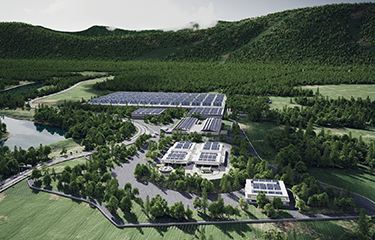Four new land-based recirculating aquaculture systems (RAS) have either recently begun operations or are being planned in Japan, founded by companies eager to bring another source of salmon to the seafood-loving island nation.
In addition to two RAS projects already in operation – Kotoura Grand Salmon and the Mitsui-owned FRD Japan – there are two new RAS salmonid projects in the works in Japan. Pure Salmon and Proximar Seafood both recently announced their intentions to construct multi-thousand-ton farms near Tokyo.
RAS farms are land-based fish production systems that treat and re-use water. They typically use bio-filtration to reduce ammonia toxicity along with other types of filtration such as sedimentation. Being less dependent of the water source, they can be sited closer to urban consumption areas. And Japan has proven an attractive location to host these RAS projects because it is a major consumer of salmon – it is currently the most popular sushi topping – and raw consumption in the form of sushi and sashimi requires freshness.
Kotoura Grand Salmon from Tottori Prefecture sells one whole silver salmon, weighing 600 to 700 grams, through an online shop on the Rakuten internet sales platform at JPY 2,980 (USD 27.30, EUR 24.38). The salmon is produced in a land-based system using groundwater and a proprietary recirculating-filtration system. The fish are also sold through Japan’s “Hometown Tax” system, in which taxpayers can pay a part of their taxes to a local area and receive a gift of a locally made product (often food) in return.
Though the Rakuten offering is a small fish, the target weight for harvest is two kilograms. The enterprise, located in Kotoura-Cho, Tohaku-gun, Tottori Prefecture, also supplies local restaurants. The facility consists of a hatchery and office building and a newer 34- by 51-meter fish farm building. This second building, completed in September 2017, contains four tanks of 14 meters in diameter and 5.4 meters in depth. Adult fish were shipped for the first time in the spring of 2018. The production target is 600 metric tons (MT) annually.
FRD Japan, Co., headquartered in Saitama City, scaled up from a small land-based trout hatchery to a larger pilot plant in Kisarazu City in Chiba Prefecture, with a target output of 30 MT of trout per year. The first harvest and retail sales were in the summer of 2019. Trading company Mitsui & Co., Ltd. acquired 80 percent of venture company FRD's shares in April 2017. The other shareholders, with 10 percent each, are Taiyousuiken Inc. (a maker of the water treatment system used) and KGC, Ltd. Trout are considered easier to farm than salmon, but in Japan, are used interchangeably with salmon in many applications. Trout farmed in salt water are usually called “salmon-trout” in Japan.
Pure Salmon, owned by private equity fund 8F Asset Management Pte. Ltd. in Singapore, is building a 10,000-ton-per-annum Japanese facility in Tsu City, Mie Prefecture utilizing RAS technology from AquaMaof Aquaculture Technologies Ltd., based in Rosh Ha’ayin, Israel. The product, Atlantic salmon sold under the name “Soul of Japan” is to be marketed by Tokyo-based trading company Itochu. Total investment of USD 152 million (EUR 136 million) is planned for production and processing facilities. Construction began in 2019 and the facility is expected to become operational in 2021, with the first products being available from 2022.
The latest entrant is Bergen, Norway-based Proximar Seafood, planning a facility of 5,300 MT annual production capacity (head-on, gutted) of Atlantic salmon at a site it has secured in Shizuoka Prefecture. Proximar has signed a contract with AquaMaof for an RAS system and a contractor for the construction work, with construction expected to start in early 2020.
RAS salmon systems are only price-competitive on paper when compared with fresh product airfreighted to Japan from Norway or Chile, according to Martin Fothergill, co-founder and partner of Singapore-based 8F Investment Partners, an investment fund that owns Pure Salmon.
“The cost of production of these facilities will be 40 percent lower than a traditional salmon farmer in Norway," Fothergill said. "We eliminate the high costs of air freight, chemicals, and antibiotics.”
But the Japanese market is not without its own domestically farmed salmon and trout. Miyagi Prefecture leads production of silver salmon raised in net pens in the ocean, with more than 15,000 MT of production annually. Nationwide, wild silver salmon catches average around 30,000 MT. The advantage for the RAS systems is their year-round fresh availability.
Photo courtesy of Pure Salmon







